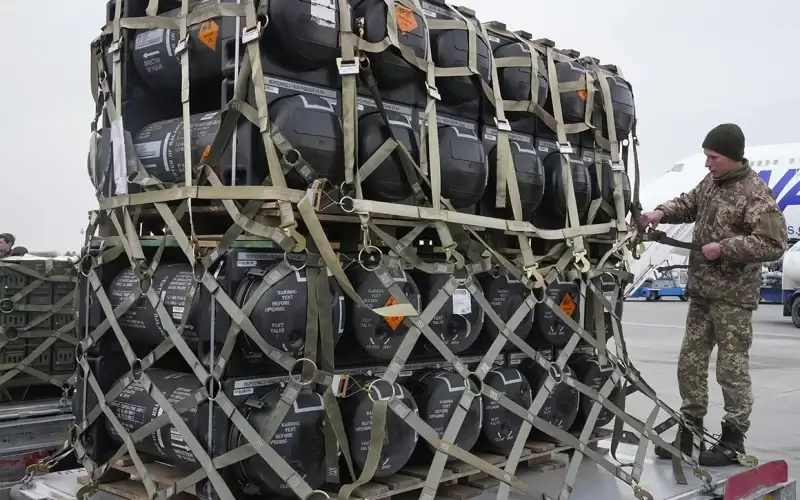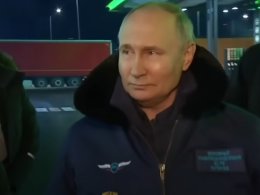Western countries are rushing heavy weaponry to Ukraine as the war enters what promises to be a deadly, and potentially protracted, new phase.
Those deliveries are coming amid increasingly desperate pleas from Ukrainian battlefield commanders as they endure withering Russian artillery and rocket fire that could last weeks or months.
Over the past two weeks, the Biden administration began shipping out $1.2 billion worth of howitzers, around 200,000 artillery rounds, armored vehicles, counter-battery radars and experimental new armed drones capable of flying into targets. The deliveries are a significant advance from the small arms and Javelin anti-tank armor shipments that dominated the first eight weeks of fighting, and which helped stave off Russian thrusts toward the capital of Kyiv in the early days of the invasion.
On Friday, France and Canada unveiled new plans to send long-range artillery systems for the first time, and the U.K. is looking to backfill heavy armor to Poland as Warsaw contemplates sending Polish tanks to Ukraine.
On Sunday, during a surprise trip to Kyiv by Secretary of State Antony Blinken and Defense Secretary Lloyd Austin, the U.S. announced more than $300 million in foreign military financing to allow Ukraine to purchase more sophisticated weapons, along with an additional $165 million for ammunition.
The rapid shift in aid reflects the recognition that the new fight will likely be dominated by artillery barrages and tank battles as infantry units square off over the flat fields of eastern Ukraine. But getting these new weapons to the front quickly will prove critical in the coming days.
As the war changes its character, a wave of Russian steel has been taking aim at Ukrainian units holding the line north of the besieged city of Mariupol, where a few hundred troops continue to make a last desperate stand on the grounds of the Azovstal steel plant.
Eighty miles north of the city, First Lt. Ivan Skuratovsky, serving in the 25th Airborne Brigade, told POLITICO that help needs to come immediately.
“The situation is very bad, [Russian forces] are using scorched- earth tactics,” the 31-year-old married father of two said via text. “They simply destroy everything with artillery, shelling day and night,” he said via text.
He fears that if reinforcements in the form of manpower and heavy weaponry — particularly air support — don’t arrive in the next few days, his troops could find themselves in the same position as those in Mariupol.
Skuratovsky described his soldiers’ situation as “very desperate.”
“I don’t know how much strength we will have,” he said, adding that the troops under his command around the city of Avdiivka, near Donetsk, have gone without rest since the start of the war. At least 13 of them have been wounded in recent weeks, he said, and they are running dangerously low on ammunition, reduced to rationing bullets.
The day before, he told POLITICO his soldiers were being bombarded with Russian howitzers, mortars and multiple-launch rocket systems “at the same time.” Just hours earlier, he said, they had been attacked by two Su-25 warplanes, “and our day became hell.”
Skuratovsky had a message for the United States and other NATO countries: “I would like to tell them that grenade launchers are good, but against airstrikes and heavy artillery we will not be able to hold out for long. People can no longer endure daily bombardments. We need air support now. We need drones.”
The lieutenant’s pleas match those of President Volodymyr Zelenskyy, who has for weeks demanded that Western countries step up their support as this new phase of the Russian war gets underway. The calls come as the Kremlin struggles to switch tactics from small unit attacks in the north in favor of devastating artillery barrages aimed at flattening towns and Ukrainian positions, unconcerned with — or perhaps purposefully looking for — civilian casualties.
The message is getting through to Western leaders, albeit slowly.
Ukrainian officials have been calling for heavy weapons and jet fighters since the Feb. 24 Russian invasion, but the Kremlin’s decision to pull its troops from around the capital of Kyiv and make one concerted push in the east and south has clearly caught the attention of Western powers.
Russian forces appear to be positioning for a pincer movement launched from the north and south that would trap at least 30,000 Ukrainian troops in the east, and possibly cut them off from resupply. As of now, weapons and aid are getting through, but as this new, more destructive phase of the Russian assault begins, counter attacking from a distance will likely be key to Ukrainian success.
Artillery has been a critical piece in the Ukrainian resistance thus far in the war, and volunteer units have effectively used commercial and homemade drones to spot Russian positions and walk in accurate artillery strikes on armored columns.
Along with the howitzers and armored vehicles, the U.S. is also sending a new capability. The new package includes 121 Phoenix Ghost drones that can fly for six hours, including at night, spotting Russian positions before being flown into a target where an embedded warhead will detonate. The drones have only been developed and built over the past several months, and the Ukrainian troops about to fly them will be the first ever to put them to use on the battlefield.
“Loitering munitions can be a significant advantage though, and the Ukrainians have proven themselves to be pretty adaptable and creative. They could make a real difference,” Rob Lee, a military analyst and a senior fellow in the Foreign Policy Research Institute’s Eurasia Program, told POLITICO.
Skuratovsky said his soldiers, who have just one quadcopter drone at their position that can be rigged to drop a small grenade, would benefit greatly from receiving the Ghost drones, which would allow them to strike Russian artillery targeting them.
On Friday, France announced it was supplying several Caesar self-propelled howitzers to Ukraine and is now training 40 Ukrainian soldiers in France on how to use the powerful guns mounted on the back of a six-wheeled truck.
The Caesar, which the French have used in Afghanistan and have sold to NATO allies, has a range of 24 to 34 miles, giving Ukrainian forces the ability to lob accurate fire at significant distances. “We stand with the Ukrainian people,” the French defense ministry said in a statement on Friday.
British Prime Minister Boris Johnson also suggested Friday that his government is considering a deal that would send British tanks to Poland, if Warsaw decides to send some of its Soviet-era T-72 tanks to Ukraine. Poland would be following the lead of the Czech Republic, which recently supplied some of its own T-72s, which the Ukrainians know how to operate.
The Kremlin has repeatedly threatened to hit the convoys of trucks coming across the Polish border full of weapons, which now include — or are about to include — much larger cargo loads, including cannons, large armored vehicles, and spare parts for Ukrainian MiG fighter planes. Western officials have long been cagey about these shipments, but so far the deliveries have arrived intact, allowing Kyiv to resupply troops along the line of contact.
A senior U.S. Defense Department official estimated this week that “the Ukrainians have more tanks in Ukraine than the Russians do,” given the huge losses Russian armor have taken as a result of Ukrainian artillery and shoulder-fired anti-armor attacks.










